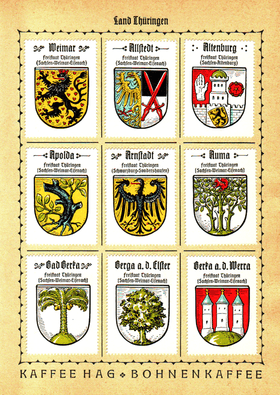Otto Hupp

Hermann Joseph Otto Hubert August Constantin Hupp (May 21, 1859 – January 31, 1949) was a German graphical artist. His main working area was heraldry, yet he also worked as a typeface designer, creating commercial symbols and metal works.
Hupp was born in Düsseldorf, the fourth of five sons of the engraver Carl Heinrich Hupp. His father made him learn engraving as his profession, and, shortly after finishing his education, he moved to Munich in 1878. Since 1891 till his death Hupp lived in the suburb Oberschleißheim. From the painter Rudolf Seitz he learned many styles of painting, and when he met the architect Gabriel von Seidl he received several contracts to paint wall and ceiling frescos.
Hupp's main field of work was heraldry, painting more than 6,000 coats of arms and writing books on heraldry. His Wappen und Siegel der deutschen Städte, Flecken und Dörfer (Coats of Arms and Seals of German Cities, Places and Villages) book series was started in 1895, but of the originally ten planned volumes only five were finished. 3,300 of his paintings of coats of arms were published as a collecting set from the coffee company Kaffee HAG from 1913–18 and 1926–38. This publication helped to make heraldry better known to the general public. Another important heraldic publication by Hupp were the Münchener Kalender (Munich calendar), of which 51 issues were published from 1885–1936 (the issue of 1933 was omitted).[1] Along with painting existing coats of arms, he also created many drafts for municipalities which were applying for new arms. Possibly his most important coat of arms was the 1923 version for the state of Bavaria, which, however, was replaced with a new version after World War II.
The first typographic works of Hupp were made in 1883. His first typeface, Neudeutsch, was published in 1899 by Genzsch & Heyse. He created several further typeface later, such as Hupp-Gotisch, Hupp-Fraktur, and Hupp-Antiqua. However, as his typefaces were not designed for standard uses, they did not spread much, and are nowadays mostly forgotten. None of them was ever converted to be used in phototypesetting.
Other significant works of Hupp include metal works for Speyer Cathedral in 1904 (which also gained him the title professor in 1906), the cover of an astronomical clock donated to the city of Munich, and the company logo of the Spaten brewery.
Though Hupp was undoubtedly an artist, he himself always denied to be called one, claiming he was just using the technique of an artist, but failing to have the creativity of one.
References
- Wolfgang Hendlmeier. Otto Hupp - Kunsthandwerker, Heraldiker, Schriftkünstler. Die deutsche Schrift, issue 2/1985 (#75), pp. 25–29. Online version at
External links
| Wikimedia Commons has media related to Coats of arms by Otto Hupp. |
- Otto Hupp in the German National Library catalogue
- Information with examples (German)
- Literature List Online-Catalog of the Staatsbibliothek zu Berlin (German)
- Biography with photo (German)
- Page on Otto Hupp with many images